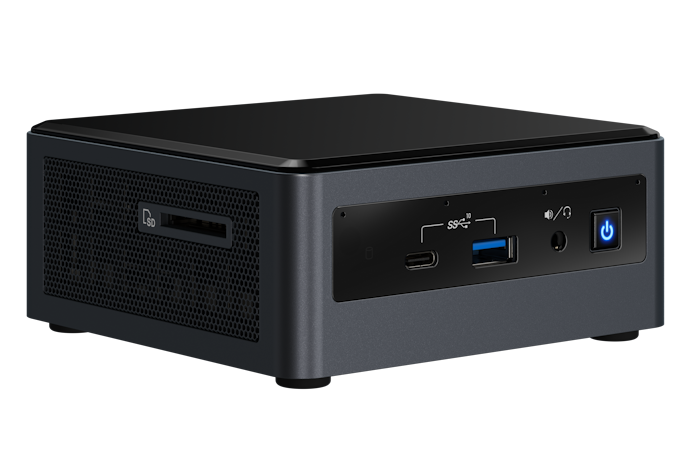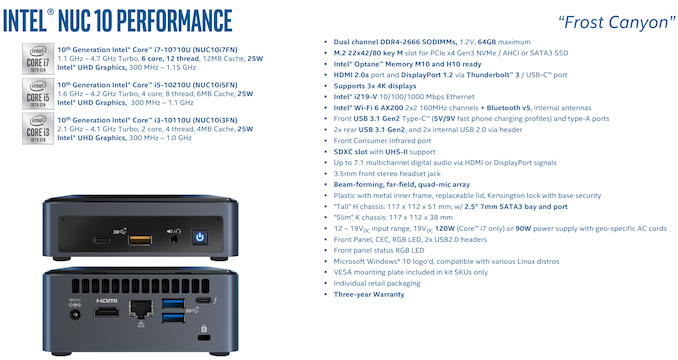Intel NUC10i7FNH Frost Canyon Review: Hexa-Core NUC Delivers a Mixed Bag
by Ganesh T S on March 2, 2020 9:00 AM ESTConcluding Remarks
The NUC10i7FNH is the latest in the line-up of mainstream NUCs from Intel. Long a niche market that Intel has dominated both directly and indirectly via its own NUCs as well as its low-TDP processors, compared where things stood a few years back, consumers these days have a number of alternatives to the mainstream NUCs. We are not referring only to the NUC clones using Intel's U-series processors, but, also the new crop of Ryzen-based UCFF PCs. The new competition means that Intel has to deliver a package that delivers more value for money compared to previous NUC offerings.
While reviewing the Bean Canyon NUC, we had indicated that it was a compact powerhouse ticking the right boxes for multiple use-cases. The tangible benefit delivered by the 'NUC8' over its predecessor was the upgrading of all the external USB ports to USB 3.2 Gen 2 (10 Gbps), and the inclusion of a more powerful Wireless-AC 9560 WLAN component. Similarly, the Frost Canyon NUC10 carries over some of the important features and also provides some welcome upgrades:
- The top-level configuration with the Core i7-10710U is a 6C/12T processor compared to the 4C/8T Core i7-8559U in Bean Canyon
- The NUC10 makes the move to Wi-Fi 6 with the AX 201 WLAN component.
- The NUC10 officially supports 64GB of DRAM (the first NUC to do so)
- One of the front panel USB 3.2 Gen 2 (10 Gbps) ports is Type-C , which is very welcome given that Type-C peripherals are becoming more prevalent now.
- The Frost Canyon NUCs make use of the latest Titan Ridge Thunderbolt 3 controller (compared to Alpine Ridge in previous NUCs), though this is transparent to the end-users of host systems. (On the peripherals side, it enables devices such as docks to talk to both Thunderbolt 3 and USB host ports).
- The BIOS has new value additions such as RAM disk creation support and pre-boot iSCSI volume mounting.
However, while the NUC8 was an upgrade over NUC7 in every respect, the Frost Canyon NUC10 slips up a little. Intel's 10th generation U-series processors come in two different versions – the 10nm Ice Lake and the 14nm Comet Lake. Intel's high-end Iris Graphics is available only on Ice Lake, and unfortunately, the Frost Canyon is based on Comet Lake. This means that, for a variety of graphics intensive workloads, the NUC10 actually performs worse than the Iris Plus graphics-equipped NUC8.
The hexa-core CPU is a nice upgrade, but, as both BAPCo SYSmark 2018 and UL's PCMark 10 show, the current typical workloads for office PCs and other generic SFF PC applications are not really capable of putting the extra cores to good use. That said, some specific tasks that scale nicely with thread counts (such as the compression and cryptography operations) can take full advantage of the capabilities offered by the Core i7-10710U in the Frost Canyon NUC10i7FNH. The availability of six cores might make the NUC an attractive option for home labs focusing on virtualization, but the requirements of the VM workloads may also need to be kept in mind given the 30W PL1 limit of the processor.
Overall, the Frost Canyon NUC10i7FNH is a mixed bag. Given a choice between, say, the Kaby Lake-based Baby Canyon NUC7 and the Coffee Lake-based Bean Canyon NUC8s, it would be a no-brainer to go for the Bean Canyon. However, choosing between Bean Canyon and Frost Canyon is not that straightforward. While Frost Canyon delivers upgrades in many respects, the retrogression in the GPU area may make the Bean Canyon NUC at a lower price point an attractive alternative. In some respects Intel has traded off GPU performance for more CPU performance, and I'm not sure that's what their NUCs really needed.
On the pricing front, the NUC10i7FNH barebones version is available for around $605, while the NUC8i7BEH is around $50 cheaper. While the two additional CPU cores and Wi-Fi 6 support can definitely justify the additional cost, it is up to the consumer to decide whether forsaking some GPU performance is also worth it.












85 Comments
View All Comments
HStewart - Tuesday, March 3, 2020 - link
I will say that evolution of Windows has hurt PC market, with more memory and such, Microsoft adds a lot of fat into OS. As as point of sale developer though all these OS, I wish Microsoft had a way to reduce the stuff one does not need.Just for information the original Doom was written totally different to games - back in old days Michael Abrash (a leader in original game graphics) work with John Carmack of Id software for Doom and Quake, Back then we did not have GPU driven graphics and code was done in assembly language.
Over time, development got fat and higher level languages plus GPU and drivers. came in picture. This also occurred in OS area where in 1992 I had change companies because Assembly Language developers started becoming a dying breed.
I think part of this is Microsoft started adding so many features in the OS, and there is a lot of bulk to drive the windows interface which is much simpler in older versions.
If I was with Microsoft, I would have options in Windows for super trim version of the OS. Reducing overhead as much as possible. Maybe dual boot to it.
HStewart - Tuesday, March 3, 2020 - link
I have some of original Abrash's books - quite a collectors item now a dayshttps://www.amazon.com/Zen-Graphics-Programming-2n...
HStewart - Tuesday, March 3, 2020 - link
And even more - with Graphics Programming Black book - almost $1000 nowhttps://www.amazon.com/Michael-Abrashs-Graphics-Pr...
Qasar - Tuesday, March 3, 2020 - link
you do know there are programs out there that can remove some of the useless bloat that windows auto installs, right ? maybe not to the extent that you are referring to, but ot is possible. on a fresh reinstall of win 10, i usually remove almost 500 megs of apps that i wont use.erple2 - Saturday, March 14, 2020 - link
This is an age old argument that ultimately falls flat in the face of history. "Bloated" software today is VASTLY more capable of the "efficient" code written decades ago. You could make the argument that we might not need all of the capabilities of software today, but I rather like having the incredibly stable OS's today than what I had to deal with in the past. And yes, OS's today are much more stable than they were in 1992 (not to mention vastly more capable)Lord of the Bored - Thursday, March 5, 2020 - link
My recollection is that was Windows Vista, not XP. XP was hitting 2D acceleration hardware that had stopped improving much around the time Intel shipped their first graphics adapter.Vista, however, had a newfangled "3D" compositor that took advantage of all the hardware progress that had happened since 1995... and a butt-ugly fallback plan for systems that couldn't use it(read as: Intel graphics).
And then two releases later, Windows 8 dialed things way back because those damnable Intel graphics chips were STILL a significant install base and they didn't want to keep maintaining multiple desktop renderers.
...
Unless the Vista compositor was originally intended for XP, in which case I eat my hat.
TheinsanegamerN - Monday, March 2, 2020 - link
you dont need a 6 core CPU for back office systems or report machines either. So they wouldnt buy this at all.Dell, HP, ece make small systems with better CPU power for a lower price then this. The appeal of the NUCs was good CPUs with iris level GPUs isntead of the UHD that everyone else used.
PeachNCream - Monday, March 2, 2020 - link
The intention of the NUC was to provide a fairly basic computing device in a small and power efficient package. Iris models were something of an aberration in more recent models. In fact, the first couple of NUC generations used some of Intel's slowest processors available at the time. timniva - Tuesday, March 3, 2020 - link
The point is that if you're making a basic computing device why even go beyond 4 cores. I kind of want a NUC as a basic browsing computer that takes up little space. I can see these being used in the office too. Many use cases for a device like this with 6 or more cores in the office, especially for folks in engineering fields running Matlab or doing development/compiling. However, in almost all of these use cases having a stronger graphics package helps, never mind gaming. Taking a step back in the GPU side, especially given what AMD is doing right now and this being in response to the competition, doesn't make much sense. Perhaps this is just to hold them over until Intel fully transitions to using AMD GPUs in the future?Lord of the Bored - Thursday, March 5, 2020 - link
Can I just say how much I love that four cores is now considered a "basic" computing device? It leaves me suffused with a warm glow of joy.